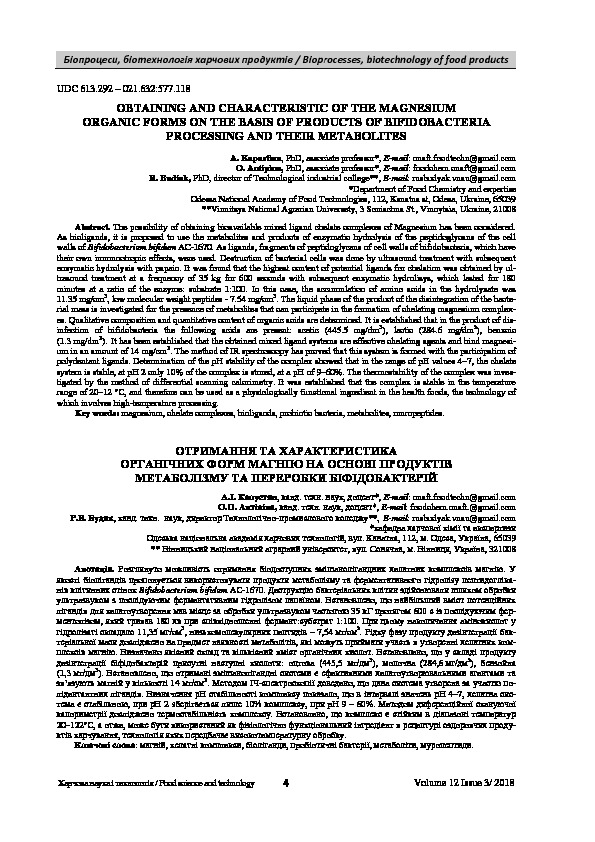id: 24771
Title: Obtaining and characteristic of the magnesium organic forms on the basis of products of bifidobacteria processing and their metabolites
Authors: Budiak R., Kapusian A., Antipina O.
Keywords: magnesium, chelate complexes, bioligands, probiotic bacteria, metabolites, muropeptides
Date of publication: 2020-05-06 10:23:50
Last changes: 2020-05-06 10:23:50
Year of publication: 2018
Summary: The possibility of obtaining bioavailable mixed ligand chelate complexes of Magnesium has been considered. As bioligands, it is proposed to use the metabolites and products of enzymatic hydrolysis of the peptidoglycans of the cell walls of Bifidobacterium bifidum AC-1670. As ligands, fragments of peptidoglycans of cell walls of bifidobacteria, which have their own immunotropic effects, were used. Destruction of bacterial cells was done by ultrasound treatment with subsequent enzymatic hydrolysis with papain. It was found that the highest content of potential ligands for chelation was obtained by ul-trasound treatment at a frequency of 35 kg for 600 seconds with subsequent enzymatic hydrolisys, which lasted for 180 minutes at a ratio of the enzyme: substrate 1:100. In this case, the accumulation of amino acids in the hydrolyzate was 11.35 mg/cm3, low molecular weight peptides - 7.54 mg/cm3. The liquid phase of the product of the disintegration of the bacte-rial mass is investigated for the presence of metabolites that can participate in the formation of chelating magnesium complex-es. Qualitative composition and quantitative content of organic acids are determined. It is established that in the product of dis-infection of bifidobacteria the following acids are present: acetic (445.5 mg/dm3), lactic (284.6 mg/dm3), benzoic (1.3 mg/dm3). It has been established that the obtained mixed ligand systems are effective chelating agents and bind magnesi-um in an amount of 14 mg/cm3. The method of IR spectroscopy has proved that this system is formed with the participation of polydentant ligands. Determination of the pH stability of the complex showed that in the range of pH values 4–7, the chelate system is stable, at pH 2 only 10% of the complex is stored, at a pH of 9–60%. The thermostability of the complex was inves-tigated by the method of differential scanning calorimetry. It was established that the complex is stable in the temperature range of 20–12 °С, and therefore can be used as a physiologically functional ingredient in the health foods, the technology of which involves high-temperature processing.
URI: http://socrates.vsau.edu.ua/repository/getfile.php/24771.pdf
Publication type: Статті у наукових фахових виданнях України (Copernicus та інші)
Publication: Харчова наука і технологія / Food science and technology. - 2018. - Vol. 12, Issue 3. - P. 4-12.
In the collections :
Published by: Адміністратор
File : 24771.pdf Size : 791476 byte Format : Adobe PDF Access : For all

| |
|
|